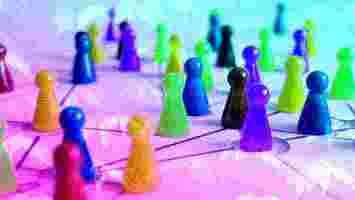Center-out management: The new leadership style in the aftermath of COVID-19
COVID-19 caught us all off guard. While many businesses worldwide struggle to make ends meet, the pandemic hit the travel and hospitality industry particularly hard.

Airlines are laying off thousands of staff members. COVID-infected cruise ships are blocked at ports. Hotel chains are wondering if they’ll be able to survive this financial year. Overall, things are looking anything but rosy.
My company is no exception. Like many companies, we’re rolling with the punches and making the best of a bad situation. Our COVID-19 response strategy draws heavily on the lessons learned from the 2008 global financial crisis.
Chief among these is the importance of building and sustaining resilient communities. We now know that strong human networks are essential for businesses to be able to withstand challenges and long-term uncertainty.
The 2008 crisis: Lessons learned
The companies that were able to survive and thrive in the aftermath of the 2008 crisis were the ones that had smart financial planning, brought real value to their customer base, and invested in their people.
That last component is often overlooked in business reports and analyses. After all, how does one measure intangible phenomena like team spirit, a sense of belonging, and community resilience? The lack of an objective metric does not trivialize the need to focus on the human element.
Pixar is a textbook example. In a 2008 piece , the company’s then-president Ed Catmull famously wrote that the job of managers is not to avoid risk but rather to build the capacity to recover quickly when failures inevitably occur.
He claimed that Pixar’s success was due to the company’s person-centered philosophy with a focus on nurturing a vibrant and supportive community that helps individuals thrive. The result was a loyal team of creative and talented people united by a common mission.
Most companies, whether they are aware of this or not, espouse an individualistic and results-driven corporate culture. Don’t get me wrong — results are important. However, they can be difficult to achieve when your team is undermotivated because of a lack of managerial support.
I’m convinced that the only way to build a business model that is both resilient and sustainable is through fostering mutual trust, support, and care for our employees and partners.
How we are supporting our partners
We have over 250,000 affiliate marketers, all of whom receive a percentage of the travel deals they sell through their websites. For some, the commissions they receive through our platform are their main or only source of income. Now, with global travel all but suspended, they find themselves in dire straits.
Our partners are absolutely essential to our business model. In fact, our company could not exist without our network of affiliates. That is why, even though the company itself is going through hard times, we decided to support our community as much as we could during the pandemic. Here’s how.
Our reimbursement scheme
First, we tracked every single flight or booking that was canceled since the outbreak of the COVID-19 pandemic. Then, we reimbursed our affiliates for all failed transactions for the whole month of April. We plan to do the same for May, when total compensations are expected to reach well over $100,000.
Positive feedback from our affiliates is what keeps the team motivated. After this crisis is over, a strong community and our partners’ trust would be the most important for us.
How much we invest in our people now will determine our success in the future. We cannot abandon our affiliates in times of crisis and expect them to want to work with us when things get better.
Resources on crisis management
With global tourism on hold for the foreseeable future, my team has been keeping busy by developing educational resources to help our community members get through the pandemic relatively unscathed.
We created a COVID-19 Survival Kit for Travel Bloggers. The guide covers pressing topics such as the latest developments in the travel market, strategies , and tactics for making the most of the current situation, future projections for the industry.
Our next initiative was a webinar on COVID-19 survival strategies for travel bloggers based in Canada, India, the UK, the US where they connected with each other to discuss pressure issues.
Final thoughts
In a 2009 piece for the Harvard Business Review , Henry Mintzberg, a professor of management studies at McGill University in Montreal, popularized the term “communityship.”
He argued that it was a much-needed and long-overdue concept that complements traditional notions of leadership. Instead of managing companies top-down, managers should start leading center-out, reaching out to the wider ecosystem that surrounds and makes all businesses possible.
I feel we should seek to put “communityship” at the center of everything that we do. We aim to support our employees, partners, and affiliates and see them through the current pandemic and any future crises. Together, we can rise better and stronger.
So you like our media brand Growth Quarters? You should join our Growth Quarters event track at TNW2020 , where you’ll hear how the most successful founders kickstarted and grew their companies.
5 low-impact workouts that’ll get you moving without pissing off your neighbors
The vast majority of us have now been cooped up working from home for two months as a result of the coronavirus pandemic .

I’m guessing you’re exhausted, bored, frustrated, anxious , and exercise may just be the only thing keeping you sane — but if you live in a flat, or share with others, working out quietly can be hard.
This is why I wanted to share several low-impact workouts that won’t risk upsetting your neighbors or flatmates.
Quiet cardio
This workout will help you break a sweat, get your heart rate up, all without bothering your downstairs neighbours.
It’s totally apartment friendly. There may be no jumping, but don’t let that fool you: this low-impact routine is still tough.
16 minutes in hell
Coronavirus may have put a complete stop to your travel plans , but there’s no reason why you can’t do this hotel -approved routine in the comfort of your own home .
Joe, the BodyCoach , will have you doing two rounds featuring eight different exercises.
You’ll work for 40 seconds and rest for 20. Sound easy? Spoiler : it’s not!
Get your groove on
Are you ready to dance? This is a serious cardio workout that’s apparently guaranteed to burn a ton of calories.
The great thing about this session is that it caters for all ability levels.
Let go of your inhibitions and get grooving and so what if you look like a complete fool? No one can see you!
Are you a beginner? This one is for you
Here’s another simple, easy-to-follow, low-impact routine for beginners .
You won’t need any equipment but feel free to add some hand weights if you want to feel the extra burn.
You’ll be standing throughout the whole routine and no jumping means no noise.
Killer abs low-impact routine
To finish off, here’s a standing routine that’ll target your abs and obliques.
There’s no equipment needed and it only lasts 10 minutes, so you literally have no excuse.
You will, however, need to have good balance and be prepared to feel your core muscles burn.
These routines will have you moving in no time, and who knows, you may even enjoy yourself — but you’ll have to try them to find out.
AI is great news for digital marketers who are bored of being data drones
Digital marketers today are faced with a unique challenge: tell a creative, compelling brand story while simultaneously fitting it to a formula that ensures the message ranks among competitors, goes viral, or is perfectly optimized for all platforms. Also, the formula changes every day without notice, so make sure you stay on top of it at all times.

What’s a digital marketer to do?
AI is here to help. I repeat, AI is here to help . There is a lingering fear that robots, AI and machine learning will replace everyone’s jobs in the next six years, but the reality is far more nuanced.
As noted by the Marketing AI Institute , some marketing jobs will go away because of AI, some will be enhanced by AI, and some new jobs will be created by AI. Marketing jobs that consist primarily of repetitive tasks or data analysis are going to be at risk.
But creativity remains in the hands of humans, even if “beauty” is in the eye of the algorithm.
Here’s why:
Farewell, A/B testing
Nothing validates a marketer’s gut instinct like A/B testing. I’ve completed thousands of A/B, multivariate, and Taguchi tests to understand which headline or image works best. It’s a marketing best practice.
Unfortunately, it’s also flawed from inception because marketers approach A/B tests with built-in bias. For example, I decided which video would be “A” and which would serve as its challenger “B.” With my human opinion involved – and the outcome I’m hoping to see in mind – the A/B test only proves two variations, ignoring outliers or subtle patterns. Machines find these outliers and patterns. AI spotlights objectivity and derives more nuance from patterns than humans can.
Machine learning has an additional one-up on A/B testing: it can predict, with statistical significance, which option is best without running the A/B test. Instead of creating a 2×2 matrix, drafting twice the assets, spending the time, budget, and energy to run the test, then reporting on outcomes and having meetings to talk about the outcomes… marketers can instead move forward with the answer in the first place!
For the last 15 years, marketers have been told to lead with data, to become more like machines. Now there’s a new call to digital marketers who will succeed: be more human. And that’s not just anecdotal. Up to 36% of business executives say the primary goal of incorporating AI into their business is to automate tasks and free up workers to be more creative.
Adieu, big data
Data wins, plain and simple. Look to big data, data lakes, data science – as marketers, we’ve been told that our opinions don’t matter unless they’re backed by data.
So, like so many marketers, I’ve become an expert in data. I’ve mastered pivot tables, vlookups and even learned a little SQL. I’ve tried to think more like a machine, and these skills have served me well. But as “big data” evolves into machine-generated insights and actions (handled by machine learning), my weak Excel formulas can’t compete.
The rapid advancement of machine learning exceeds any competitive edge that I’ve ever had. Even several years ago, enterprise CMOs were looking to machine learning to improve customer experience and support. Today, that extends to examining what people want and when they want it. The machines are winning.
Except in one critical area: creativity. Humans are the only creators.
Hello to the new beginning of creativity
There are hundreds of fitness wear brands out there. Hundreds of shoe companies, high fashion, subscription boxes, you name it. Every field is crowded, and every brand is vying for attention. The one thing that sets them all apart? Creative.
Creative introduces variance into the algorithm and finds new winners. Creative prompts the machines to find the quirks, the outliers, the “that’s interesting” data that we can’t see from a 30,000-foot view. It’s ironic, but machines will make us more creative.
And that’s where you come in – your wild idea, your liberal arts degree. That concept banging around in your head that you haven’t had the data to prove. Now you can pre-test it and see if it resonates.
Machines can optimize, but only humans can make something that stands out and is beautiful. Beauty is in the eye of the beholder, but it needs to serve the algorithm that dictates digital marketing success. Now you can have both.
Did you know we have an online conference about digital marketing coming up? Re:Brand will share strategies on how brands can still succeed in these unprecedented times.